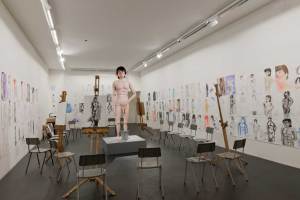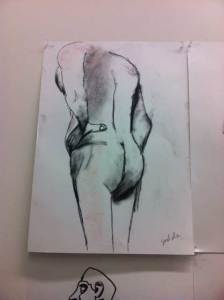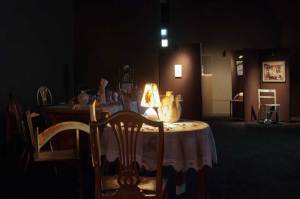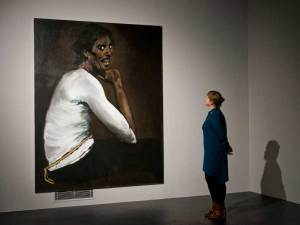A humorous thread may run through this year’s Turner Prize, but it’s not all fun and games; there is some serious and seriously intelligent art on show. Less a showy spectacle than previous years, the first ever display of the nominated artists outside England is housed in a specially designed gallery in a former military barracks in Derry. Accessed by crossing the city’s Peace Bridge, this once divisive space, with its call for communality, makes an apt site for an exhibition that invites public interaction.

Life Model (2012), David Shrigley © David Shrigley, Tate. Photo: Lucy Dawkins
At the centre of David Shrigley’s installation Life Model (2012) is a pissing, blinking, 3m-tall nude male figure. Outrageously ill-proportioned, the cartoonish kinetic sculpture is circled by chairs and easels; on an adjacent desk lie all manner of artistic tools. The audience are invited to pick up a pastel; their drawings are then displayed on the surrounding walls. Giant heads jostle with bare bums, all artfully shaded of course.

Apollo’s contribution to the Turner Prize
These renderings will always remain imperfect due to Shrigley’s anatomically incorrect figure; even an accurate likeness will appear flawed. Known for his cynical angst-ridden drawings, this work seems to carry failure at its heart. And yet it feels liberating in its fight against perfection. Picking up an easel for the first time since an A-level art class, I felt free to really go for it, even if the end result was a charcoaled mess.
Does this self-deprecating artwork – the sense that the end result will never be good enough – reference Shrigley’s own unease at being nominated? Perhaps this ungainly exposed figure is representative of Shrigley himself. One thing’s for sure, the kids will love it.
Shrigley’s work playfully questions technical artistic skill. Laure Prouvost’s work engages similarly with art history, in the way that it knowingly defies traditional categorisation. Wantee (2013), an immersive film installation, focuses on the artist’s fictional grandfather, once a close friend of German artist Kurt Schwitters. Entering a dark room, we sit around a grubby dining room table that is reminiscent of a Mad Hatter’s Tea Party. The teapots themselves are even madder; garishly detached red lips are stuck on the sides, poised to speak.

Laure Prouvost’s installation Mad Hatter-like installation
Speech, language, stories; wordy references define Prouvost’s work. She is interested in slippages, where things get lost or transformed. Her French accent punctures the film’s swerving narrative, forcing us to also mishear; ‘want tea’ is contorted into ‘wantee’. The teacups appear on screen, spliced between images of a ramshackle house, lush countryside and abstracted body parts. Visually overloaded, we are lost in a sensuous world that is half real, half made up. Yet in spite of all this fragmented silliness, we hear what Prouvost has to say, loud and clear.
Particularly striking is Prouvost’s dark humour. The chaotic life of her grandfather – an eccentric conceptual artist – is scattered around the house; briefly famous, his works are now used as rubbish bins. We discover that his final ‘concept’ was to escape down a tunnel in a final push into oblivion.

Lynette Yiadom-Boakye’s work at the Turner Prize © Yiadom-Boakye, Tate. Photo: Lucy Dawkins
Fictional characters also populate the mesmerising paintings of Lynette Yiadom-Boakye. Painting from both memory and imagination, Yiadom-Boakye creates stories that remain incomplete. Her large figurative canvasses, all depicting black subjects, are spot-lit in a dark room, drawing attention to the white eyes, grins, socks and shirts. Theatrical in their suspended animation and forcibly holding our gaze, they challenge the traditions of European portraiture.
Seemingly historical, these works deliberately withhold details; they are placeless, genderless, classless. Signalling the inherent problems of representation, these works are frustrating and somewhat contrived, but our inability to fix them down is part of their strength.
Confrontation is central to Tino Sehgal’s work. Here, he shows a version of This is exchange, first exhibited in 2003. The bare space is populated with black-clad figures who insist on talking. I’m accosted as I walk through, forced to join a large group of visitors discussing market exchange. I’m bluntly asked for my opinion, and suddenly everyone is staring at me; I want to run back to Shrigley’s classroom.
Granted, economics is not my forte. But this interaction seemed one-sided and intimidating, the questions too forcibly intellectual; Sehgal’s interpreters have the upper hand. In my group, people tried to outdo the host until he held up his hands in exasperation, saying ‘Don’t shoot the messenger!’ Of course, it’s not supposed to be about who knows more, but I wonder if feeling stupid is part of the experience. If you can sustain the conversation you’re rewarded with £2, the debate suddenly caught up in a quantifiable value system.
I get it, this encouraging of debate that can relate freely to its context (many people ended up talking about Derry’s unemployment and the impact of the financial crisis). And yes, it raises all sorts of questions about the value of art itself. But it left me cold – it seemed circular, cocky, shallow.
For her supremely imaginative, surreal, intelligent work, Prouvost is my choice. But I have a feeling that Sehgal’s minimal, overtly serious work will talk itself into the cash prize.
The Turner Prize is at Building 80/81, Ebrington, Derry, until 5 January 2014.

Eye on the Prize
Share
A humorous thread may run through this year’s Turner Prize, but it’s not all fun and games; there is some serious and seriously intelligent art on show. Less a showy spectacle than previous years, the first ever display of the nominated artists outside England is housed in a specially designed gallery in a former military barracks in Derry. Accessed by crossing the city’s Peace Bridge, this once divisive space, with its call for communality, makes an apt site for an exhibition that invites public interaction.
Life Model (2012), David Shrigley © David Shrigley, Tate. Photo: Lucy Dawkins
At the centre of David Shrigley’s installation Life Model (2012) is a pissing, blinking, 3m-tall nude male figure. Outrageously ill-proportioned, the cartoonish kinetic sculpture is circled by chairs and easels; on an adjacent desk lie all manner of artistic tools. The audience are invited to pick up a pastel; their drawings are then displayed on the surrounding walls. Giant heads jostle with bare bums, all artfully shaded of course.
Apollo’s contribution to the Turner Prize
These renderings will always remain imperfect due to Shrigley’s anatomically incorrect figure; even an accurate likeness will appear flawed. Known for his cynical angst-ridden drawings, this work seems to carry failure at its heart. And yet it feels liberating in its fight against perfection. Picking up an easel for the first time since an A-level art class, I felt free to really go for it, even if the end result was a charcoaled mess.
Does this self-deprecating artwork – the sense that the end result will never be good enough – reference Shrigley’s own unease at being nominated? Perhaps this ungainly exposed figure is representative of Shrigley himself. One thing’s for sure, the kids will love it.
Shrigley’s work playfully questions technical artistic skill. Laure Prouvost’s work engages similarly with art history, in the way that it knowingly defies traditional categorisation. Wantee (2013), an immersive film installation, focuses on the artist’s fictional grandfather, once a close friend of German artist Kurt Schwitters. Entering a dark room, we sit around a grubby dining room table that is reminiscent of a Mad Hatter’s Tea Party. The teapots themselves are even madder; garishly detached red lips are stuck on the sides, poised to speak.
Laure Prouvost’s installation Mad Hatter-like installation
Speech, language, stories; wordy references define Prouvost’s work. She is interested in slippages, where things get lost or transformed. Her French accent punctures the film’s swerving narrative, forcing us to also mishear; ‘want tea’ is contorted into ‘wantee’. The teacups appear on screen, spliced between images of a ramshackle house, lush countryside and abstracted body parts. Visually overloaded, we are lost in a sensuous world that is half real, half made up. Yet in spite of all this fragmented silliness, we hear what Prouvost has to say, loud and clear.
Particularly striking is Prouvost’s dark humour. The chaotic life of her grandfather – an eccentric conceptual artist – is scattered around the house; briefly famous, his works are now used as rubbish bins. We discover that his final ‘concept’ was to escape down a tunnel in a final push into oblivion.
Lynette Yiadom-Boakye’s work at the Turner Prize © Yiadom-Boakye, Tate. Photo: Lucy Dawkins
Fictional characters also populate the mesmerising paintings of Lynette Yiadom-Boakye. Painting from both memory and imagination, Yiadom-Boakye creates stories that remain incomplete. Her large figurative canvasses, all depicting black subjects, are spot-lit in a dark room, drawing attention to the white eyes, grins, socks and shirts. Theatrical in their suspended animation and forcibly holding our gaze, they challenge the traditions of European portraiture.
Seemingly historical, these works deliberately withhold details; they are placeless, genderless, classless. Signalling the inherent problems of representation, these works are frustrating and somewhat contrived, but our inability to fix them down is part of their strength.
Confrontation is central to Tino Sehgal’s work. Here, he shows a version of This is exchange, first exhibited in 2003. The bare space is populated with black-clad figures who insist on talking. I’m accosted as I walk through, forced to join a large group of visitors discussing market exchange. I’m bluntly asked for my opinion, and suddenly everyone is staring at me; I want to run back to Shrigley’s classroom.
Granted, economics is not my forte. But this interaction seemed one-sided and intimidating, the questions too forcibly intellectual; Sehgal’s interpreters have the upper hand. In my group, people tried to outdo the host until he held up his hands in exasperation, saying ‘Don’t shoot the messenger!’ Of course, it’s not supposed to be about who knows more, but I wonder if feeling stupid is part of the experience. If you can sustain the conversation you’re rewarded with £2, the debate suddenly caught up in a quantifiable value system.
I get it, this encouraging of debate that can relate freely to its context (many people ended up talking about Derry’s unemployment and the impact of the financial crisis). And yes, it raises all sorts of questions about the value of art itself. But it left me cold – it seemed circular, cocky, shallow.
For her supremely imaginative, surreal, intelligent work, Prouvost is my choice. But I have a feeling that Sehgal’s minimal, overtly serious work will talk itself into the cash prize.
The Turner Prize is at Building 80/81, Ebrington, Derry, until 5 January 2014.
Unlimited access from just $16 every 3 months
Subscribe to get unlimited and exclusive access to the top art stories, interviews and exhibition reviews.
Share
Recommended for you
Spoiled
Is the huge cache of art discovered recently in Cornelius Gurlitt’s Munich flat in safe hands?
Book Competition
This month’s book competition offers you the chance to win ‘Sex on Show: Seeing the Erotic in Greece and Rome’ by Caroline Vout
Ghost House
Rachel Whiteread’s ‘House’ was unveiled 20 years ago today. It stood for barely three months, but its influence endures